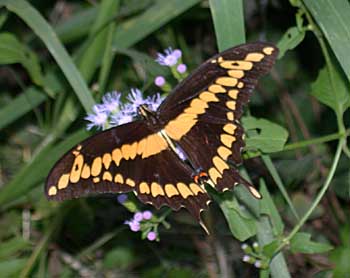OCCURRENCE OF THE GIANT SWALLOWTAIL (PAPILO CRESPHONTES) IN NORTHERN BAJA CALIFORNIA
Richard A. Erickson (A, C), Marshall J. Iliff (B)
A. LSA Associates, 20 Executive Park, Suite 200, Irvine, CA 92614,
B. 246 East 16th Street, Unit B, Costa Mesa, CA 92627,
C. Correspondent: E-mail: richard.erickson(at)lsa-assoc.com
Abstract
Beginning in the 1960s, the familiar giant swallowtail (Papilo cresphontes) expanded its range into southern California from the east. From
1996 through 2003, at least 23 giant swallowtails were seen at 13 locations in the northern portion of the Baja California Peninsula, representing the
first records of this species in the Mexican state of Baja California.
|



 But the overall effect is a good camoflage mimicing bird droppings.
But the overall effect is a good camoflage mimicing bird droppings.


 . They also have a similar shape to the head and body
. They also have a similar shape to the head and body
